
The Navy Department Library
- Board War Games in the Collection of the Navy Department Library
- British Admiralty Prize Case Books, 1780-1822, in the Navy Department Library
- Commissioning Certificates of US Navy Officers in the Navy Department Library.
- Conference Transcripts of the Allied Combined Chiefs of Staff
- Cruise Books - Ships, Seabees and Training/Education
- Cryptologic Documents in the Navy Department Library
- Dept. of the Navy Documents in Record Groups (RG) at the National Archives & Records Administration (NARA)
- Expand navigation for George Henry Preble Collection George Henry Preble Collection
- German Navy U-boat (Submarine) Headquarters War Logs from World War II
- Guide to United States Naval Administrative Histories of World War II
- Guide to US Naval Administrative Histories of WWII - Appendices
- Irregular Warfare Reading Room
- Expand navigation for Lists of Senior Officers and Civilian Officials of the US Navy Lists of Senior Officers and Civilian Officials of the US Navy
- Naval Air Force, US Atlantic Fleet
- Naval Air Force, US Pacific Fleet
- Amphibious Force, US Atlantic Fleet
- Amphibious Force, US Pacific Fleet
- Atlantic Command, Commander in Chief US
- Commander Sixth Fleet
- Fifth Fleet Commanders
- Expand navigation for Commander First Fleet Commander First Fleet
- Commander in Chief US Allied Forces Southern Europe
- List of Assistant Secretary of the Navy
- Assistant Secretary of the Navy (AIR)
- Assistant Secretary of the Navy (Financial Management)
- Assistant Secretary of the Navy (Installation and Environment)
- Assistant Secretary of the Navy (Manpower and Reserve Affairs)
- Office of Naval Material
- Assistant Secretary of the Navy (Research Development and Acquisition)
- Bureau of Aeronautics
- Bureau of Equipment and Recruitment
- Bureau of Medicine and Surgery
- Bureau of Naval Personnel
- Bureau of Ships
- Bureau of Steam Engineering
- Bureau of Supplies and Accounts
- Bureau of Yards and Docks
- Chief of Chaplains
- Expand navigation for Chiefs of Naval Operations Chiefs of Naval Operations
- Commander in Chief US Naval Forces Europe
- Commander, Naval Education and Training Command.
- Commander Seventh Fleet
- Commanders, Naval Legal Service Command
- Director of Naval Reserve
- Expand navigation for District Commanders District Commanders
- Former Directors
- Gray Eagles
- Japan, Commander US Naval Forces
- Judge Advocate General of the Navy
- Naval Electronic Systems Command Headquarters
- Office of Information
- Secretaries of the Navy
- Under Secretary of the Navy
- Vice Chief of Naval Operations
- Washington Navy Yard, Commandants
- Maritime Research: Selected Institutions With Significant Collections
- Military History and National Security
- Military Service Records and Unit Histories: A Guide to Locating Sources
- Expand navigation for Modern Biographical Files in the Navy Department Library Modern Biographical Files in the Navy Department Library
- Expand navigation for Modern Bios A Modern Bios A
- Abbot, Edward W.
- Abbot, James Lloyd
- Abbott, Clark Tait
- Abbott, William George
- Abbott, Robert Lewis
- Abele, Mannert Lincoln
- Abercrombie, Laurence Allen
- Abercrombie, William Warner
- Abernethy, Elmer Paul
- Abhau, William Conrad
- Abplanalp, Kenneth Clair
- Abrahams, Noble Wayne
- Acker, Frank Clements
- Ackerman, Edward
- Ackiss, Ernest Lee
- Acuff, Jasper Terry
- Adair, Charles
- Adair, Crutchfield
- Adair, Jamie
- Adam, James D.
- Adams, Allen Bond Jr.
- Adams, Benjamin Harrison
- Adams, Carlton Rolla
- Adams, Charles Francis, III
- Adams, Dudley Hale
- Adams, Frank Eugene
- Adams, John Clausel
- Adams, Lenus Franklin
- Adams, Lynn W.
- Adams, Richard Donald
- Adams, Robert Lee
- Adams, Scarritt
- Adams, Spencer Moore
- Adams, Thomas McConnell
- Adams, Woodbury Sanderson
- Adamson, Frank Marshall
- Adamson,Robert Edward Jr
- Adee, Graham Montrose
- Adell, Bruce Byron
- Adell, Cecil Clinton
- Adkins, James Alvin
- Adkins, Joe Dean
- Adrian, Robert Nelson
- Ageton, Arthur Ainsley
- Agnew, Dwight Merle
- Agnew, Henry Follin
- Agnew, Jack
- Agnew, William John Clarke
- Ahern, James Richard
- Ahl, Benjamin Nathaniel
- Ahroon, Thomas Andrew
- Aiau, Harvey Chadwick Kamohoalii
- Ailes, John William, III
- Ainsworth, Herbert Sylvan
- Ainsworth, Walden Lee
- Akers, Frank
- Albers, John Juergen
- Albert, Francis Lee
- Albin, George Waugh
- Albright, Paul Morris
- Albrittain, John Warren
- Alderman, John Clement
- Alderton, Dickson Wellington
- Aldrich, Charles Warren
- Aldrich, Clarence Edward
- Aldrich, Clarence Edward, Jr.
- Aldridge, Eugene Talbert
- Alexander, Joe McKnitt
- Alexander, John Richmond
- Alexander, Marion Snow
- Alexander, Ralph Clonts
- Alexander, Raymond Wellington
- Alexander, Richard Griffiss
- Alexander, Stanley Morton
- Alexander, William Henry
- Alexis, Algert Daniel
- Alford, John Morris
- Alford, Leon Otto
- Alford, Lodwick Houston
- Alford, Zeb Dickey
- Allan, Halle Charles
- Allan, Theodore DeWitt
- Alldredge, Walter Whitmore
- Allegrone, Charles
- Allen, Archer Meredith Ruland
- Allen, Burrell Clinton Jr.
- Allen, Charles Vern
- Allen, Edward Henry
- Allen, Ezra Griffen
- Allen, James Ross
- Allen, Jerome Lee
- Allen, Max Harold
- Allen, Nelson John
- Allen, Robert Addison
- Allen, Roger Hurst
- Allen, Walter Hinds
- Allen, William Young, Jr
- Allendorfer, Harry Carl, Jr.
- Allis, Frederick Ashton
- Allison, Samuel Francis
- Allshouse, Thomas James
- Almgren, Neal
- Alston, Augustus Howard, Jr.
- Altmann, Richard Gustaf
- Alvarez, Everrett, Jr.
- Alvis, Harry James
- Alvis, John Hubbard
- Amberson, Julius Martin
- Ambruster, Stephen Henry
- Amen, William Thomas
- Amme, Carl Henry Jr.
- Ammen, Daniel
- Ames, Lionel Eugene Jr.
- Ammon, William Bronley
- Amsden, William Faulkner
- Ancrum, William
- Anderson, Anton Bennett
- Anderson, Bern
- Anderson, Carl Eric
- Anderson, Charles Carter
- Anderson, Charles Harper Jr.
- Anderson, Clyde Bertram
- Anderson, Edward Abel
- Anderson, Edward Lee
- Anderson, Edwin Alexander
- Anderson, Fernald Philip
- Anderson, Franklin Warren
- Anderson, George W.
- Anderson, Herbert Augustus
- Anderson, Herbert Henry
- Anderson, Jay Stephens
- Anderson, Joseph Bruce
- Anderson, Kenneth Leroy
- Anderson, Norman Oliver
- Anderson, Paul Ramseur
- Anderson, Richard Beatty
- Anderson, Richard Ernest
- Anderson, Robert Harold
- Anderson, Roy Gene
- Anderson, Samuel Clay
- Anderson, Thomas Carlyle
- Anderson, Vernon Leroy
- Anderson, Walter Stratton
- Anderson, William Donald
- Anderson, William Lovett
- Anderson, William Robert
- Anderton, Henry Lafayette Jr.
- Andrews, Adolphus
- Andrews, Burton Howell
- Andrews, Cecil L.
- Andrews, Charles Herbert
- Andrews, Charles Lee Jr.
- Andrews, Clyde Cecil
- Andrews, Edgar Clessie Jr
- Andrews, Frank Arland
- Andrews, John Jr.
- Andrews, Mark Edwin
- Andrews, Richard Stottko
- Andrews, Thomas Loftin Jr.
- Andrews, Walter Edwards
- Andrus, Carlton Leverett
- Angas, William Mack
- Angwin, William Arnold
- Ansel, Walter Charles
- Antle, William Smoot Jr.
- Antoniak, Charles
- Antrim, Archie Arthur
- Antrim, Richard Nott
- Appleby, Charles Albert
- Appleby, Jack Jestiny
- Arbes, James Douglas
- Arbo, Paul Edward
- Arbor, Jesse Walter
- Archambeault, Charles Paul
- Archer, Robert John
- Archer, Stephen Morris
- Arison, Rae Emmett
- Armel, Lyle Oliver
- Armentrout, Erasmus Wilson Jr
- Armstrong, Daniel Williams
- Armstrong, Henry Jacques
- Armstrong, James Houston
- Armstrong, John Hord Jr.
- Armstrong, Parker Broadhurst
- Armstrong, Philip McCutcheson Jr.
- Armstrong, Robert Gordon
- Armstrong, Theodore Hamilton
- Armstrong, Wade Herbert
- Arndt, Ralph William
- Arnett, A.B. Jr.
- Arnold, Henry Albert
- Arnold, Jackson Dominick
- Arnold, James Earl
- Arnold, Malcolm Wesley
- Arnold, Murr E.
- Arnold, Ralph Judd
- Arthur, John Paul
- Arthur, Lionel Alexander
- Arthur, Samuel Hyer
- Ashford, George Woodson
- Ashford, William Henry Jr.
- Ashe, George Bamford
- Ashworth, Frederick L
- Askin, Robert Marshall
- Askins, Herbert R.
- Asserson, William Christian Jr.
- Astor, William Vincent
- Austin, Bernard Lige
- Atkins, James George
- Atkins, Griswold Terry
- Atkins, Nevett Brooke
- Ault, Frank Willis
- Ault, William Bowen
- Austin, Marshall Harlan
- Aurand, Evan Peter
- Austin, Leonard Bynner
- Ausley, Joe Henry, Jr.
- Austin, Frank Hutches, Jr.
- Axene, Dean Lane
- Azer, John Behling
- Ayres, James Edward
- Aymond, John Paul
- Awtrey, Hugh Rainey
- Atkins, Robert Boyer
- Averill, William Renick
- Avery, Bennett Franklin
- Avery, Howard Malcolm
- Atherton, Harry Sheldon
- Austin, Charles Linnell
- Aylward, Theodore Charles
- Atkinson, Roy Charles
- Auken, Wilbur R.
- Expand navigation for Modern Bios B Modern Bios B
- Babbitt, Arlene Keith
- Babione, Robert William
- Bach, Lawrence Earl
- Bache, George Mifflin
- Bachman, Leo Adolph
- Backus, Standish Jr.
- Bacon, Barton Elijah Jr.
- Bacon, Walter Griswold
- Badger, Charles Johnson
- Badger, Harold Raymond
- Badger, Harry Peaslee
- Badger, Oscar Charles
- Badger, Rodney Jenkins
- Badt, Harry Asher
- Baer, Donald G.
- Bagdanovich, Michael Peter
- Baggaley, William
- Bagley, David Harrington
- Bagley, David Worth
- Bagley, Harry Howe
- Bahm, George Henry
- Bailey, Carlos Augustus
- Bailey, Charles Streater
- Bailey, John
- Bailey, Leonard William
- Bailey, Watson Osgood
- Bailey, William Byron
- Bains, George Washington
- Baird, Abraham Lincoln
- Baird, Charles Fitz
- Baird, Leonard James
- Bakenhus, Reuben Edwin
- Baker, Charles Adams
- Baker, Douglas
- Baker, Duncan Scott
- Baker, Felix Locke
- Baker, Guy Evans
- Baker, Harold Davies
- Baker, Harold Edward
- Baker, Robert Leon
- Baker, Robert Nicholson Scott
- Baker, Wilder Dupuy
- Baker, William Bostock
- Bakke, Harlan James
- Bakutis, Fred Edward
- Baldridge, Harry Alexander
- Baldwin, Frank
- Baldwin, Frank Edward
- Baldwin, Robert Bemus
- Baldwin, Robert Hayes Burns
- Balis, Theodore Lawrence
- Ball, Claude Russell
- Ball, George Cornelius Jr.
- Ball, John
- Ballard, Donald Everett
- Ballenger, Felix Pettey
- Ballentine, John Jennings
- Ballinger, John Montgomery
- Ballinger, Richard Robert
- Baltazzi, Harry Warner
- Banister, Alan B.
- Banks, James Oliver
- Bannerman, Graeme
- Bantz, Fred A.
- Barbaro, Joseph Raphael
- Barbee, Albert Ray Jr.
- Barber, Ernest Hayes
- Barbey, Daniel Edward
- Barchet, Stephen George
- Bard, Nathan Wayne
- Bard, Ralph A.
- Bardshar, Frederic Abshire
- Barham, Eugene Alexander
- Barker, Christopher Sylvanus Jr.
- Barker, Edwin Franklin
- Barker, George Nathan
- Barker, Joseph Henry Jr.
- Barker, Nathaniel Charles
- Barlow, Jerry Moulton
- Barlow, John Francis
- Barnaby, Neel Glenn
- Barnaby, Ralph Stanton
- Barnard, Harry Allan Jr.
- Barnard, James Hills, II
- Barner, James Duke
- Barnes, Ernest Richard
- Barnes, Phillip George
- Barnes, Samuel Edward
- Barnes, William Roy
- Barnett, Austin Hill Jr.
- Barney, Greenlief Haskell
- Barnhart, Robert Ernst
- Barnitz, James Wanner
- Barnwell, Joseph Brunson
- Baron, Richard Swan
- Barrett, John Paul Barker
- Barringer, Victor Cameron, Jr.
- Barron, John Powers
- Barrow, William Ballard Jr.
- Barthes, August Aloysius
- Bartlett, Bradford
- Bartlett, Harold Terry
- Bartlett, James Vincent
- Bartlett, John Russell
- Bartlett, Lewis Clark
- Bartol, John Alfred
- Barton, John Kennedy
- Barr, Capers Gamewell Jr.
- Barr, Eric Lloyd Jr.
- Barr, Norman Lee
- Barry, Richard P.
- Barton, Leroy Lewis
- Barton, Wilbur Gardner
- Baskett, Thomas Slack
- Bass, Harry Brinkley
- Bass, Ivan Ernest
- Bass, Raymond Henry
- Bass, Thomas Edward III
- Bassett, Claude Oscar
- Bassett, Frederic Brewster Jr.
- Bassett, Melvin Hughes
- Bassett, Robert V.R., Jr.
- Bassler, Robert Edward
- Bastedo, Paul Henry
- Batchelder, Robert Fred
- Batcheller, Edgar Hadley
- Batchellor, John Kenneth
- Bates, Joseph Clark Jr.
- Bates, Ralph
- Bates, Richard Waller
- Battle, Charlton Eugene, Jr.
- Bauch, Charles Everett
- Bauer, George William
- Bauer, Louis Hallowell
- Bauer, Rudolph Charles
- Bauernschmidt, George William
- Baugh, Dalton Louis, Sr.
- Baughan, Robert Louis, Jr.
- Baughman, Cortlandt Chesterfield
- Baum, George Martin
- Baumberger, Walter Harlen
- Baumeister, John Jr.
- Baumer, Harry William
- Baumgartner, John Peter
- Beam, Carl Eugene
- Bean, Alan Lavern
- Beard, Donald Charles
- Bean, Lawrence Lytton
- Beard, Jefferson Davis
- Beardall, John Reginald
- Beardslee, Lester Anthony
- Beardsley, George Francis
- Beardsley, Henry Leidenheimer
- Bearss, Hiram Iddings
- Beary, Donald Bradford
- Beasley, Charles Black
- Beatty, Frank Edmund
- Beatty, Frank Edmund Jr.
- Beauchamp, Ernest Mortimer
- Beaumont, Arthur Edwaine
- Beaumont, Richard Austin
- Beauregard, Augustin T.
- Beaver, Bud Kearns
- Beaver, Robert Harmon
- Beck, Edward Louis
- Becker, Adolph Ernest Jr.
- Becker, Albert Lilly
- Becker, Alvin Lannard
- Becker, Charles
- Becker, John Joseph
- Becknell, Thomas Leonard Jr.
- Becton, Frederick Julian
- Bedell, Floyd Carson
- Bedell, Porter Fryman
- Beebe, Marshall Ulrich
- Beebe, Robert Park
- Beecher, William Gordon Jr.
- Beggs, Kenneth Gould
- Behan, Austin Carity
- Behm, Edward William
- Behner, Herbert Chauncey
- Behnke, Albert Richard Jr.
- Behrens, Charles Frederick
- Behrens, William Wholsen Jr.
- Behrens, William Wohlsen
- Belcher, Preston Randolph
- Belcher, Roy S. Jr.
- BeLieu, Kenneth E.
- Beling, John Kingsman
- Belin, Peter
- Belknap, George Eugene
- Belknap, Reginald Rowan
- Bell, Clarence Edwin
- Bell, David Bonar
- Bell, Frederick Jackson
- Bell, George Mefford
- Bell, Harman Brown
- Bell, Robert Alexander
- Bellerby, Russell John
- Belles, Ralph Glenn
- Bellinger, Patrick Nieson Lynch
- Bellinger, William C.P. Jr.
- Bernatitus, Ann Agnes
- Benfold, Edward Clyde
- Bengtson, Bengt Norman
- Benham, Andrew Ellicott Kennedy
- Benitez, Rafael Celestino
- Benjes, Anthony Christian Jr.
- Bemis, Harold Medberry
- Bennehoff, Olton Rader
- Benner, Stanley Graves
- Bennett, Andrew Carl
- Bennett, Bradley Frederick
- Bennett, Carter Lowe
- Bennett, Earl Robert
- Bennett, Earle
- Bennett, Edward L
- Bennett, Floyd
- Bennett, Fred G
- Bennett, John Edward
- Bennett, Rawson II
- Bennett, Walter Francis Vincent
- Bennett, Warfield Clay Jr.
- Bennington, John Paige
- Bennion, Mervyn Sharp
- Benson, Francis Wyse
- Benson, Howard Hartwell James
- Benson, Lloyd George
- Benson, Roy Stanley
- Benson, Victor Gordon
- Benson, William Howard
- Bentley, James Alexander
- Bentley, James Calvin
- Benton, Hugh Arthur
- Berg, Winfred Emil
- Bergen, Franklin Steward
- Bergen, John Joseph
- Bergeson, Andrew Harold
- Bergin, Charles Kniese
- Bergin, Daniel Edward
- Bergner, Allen Alfred
- Bergstedt, William Charles
- Bergstrom, Edward William
- Berkheimer, Jack Stanley
- Berkley, Joseph Berzowski
- Berkley, William Leneave
- Bernard, Lawrence George
- Bernet, Howard Cavender
- Bernhard, Alva Douglas
- Berkner, Llloyd Viel
- Berkey, Russell Stanley
- Berley, Ferdinand Victor
- Berndtson, Arthur Henry
- Berner, Warren Kenneth
- Berns, Max Arnold Jr.
- Bernstein, Henry Emil
- Berree, Norman Rahn
- Berrey, Julius M.
- Berrien, Frank Dunn
- Berry, Arthur Frank Jr.
- Berry, Charles Joseph
- Berry, Fred Thomas
- Berry, Fred Thomas, Jr.
- Berry, Frederic Aroyce
- Berry, Howard Burton Jr.
- Berry, Ralph Bryon
- Bertelli, Peter
- Bertelsen, Viggo Christian
- Berthold, Elmer Edward
- Bertholf, Charles Marriner
- Berthrong, Raymond
- Bertoglio, Floyd John
- Bertoglio, Lloyd Webb
- Bertolet, Samuel
- Bertschy, Robert Sylvester
- Berude, John Berthold
- Besbekos, George Angelo
- Beshany, Philip Arthur
- Besson, John Henry Jr.
- Best, William Alexander
- Bethea, James Stephen
- Betts, Sherman Wilcox
- Beuret, John Dougall
- Bevan, George Ronald
- Beveridge, Richard Alexander
- Bewick, James Voigt
- Beyer, Aaron Frederick Jr.
- Beyerly, Irwin Forest
- Bibby, Lowe Hayden
- Biddle, Edward
- Biederman, Karl Joseph
- Bieg, Valentine Nicholas
- Bienia, John Paul
- Bierer, Bion Barnett Jr.
- Bierer, James Shadel
- Bieri, Bernhard Henry
- Bieri, Bernhard H. Jr.
- Biesemeier, Harold
- Bigley, Thomas Joseph
- Bigelow, Elmer Charles
- Biglow, James Otis
- Biggs, Burton Beecher
- Bill, Wells Rood Jr.
- Billingsley, William Devotie
- Binford, Thomas Howell
- Bingham, Donald Cameron
- Bird, Horace Virgil
- Bird, Joseph Lenoir
- Biros, Edmund William
- Blakely, Edward Noe
- Bulkeley, John Duncan
- Burke, Arleigh A
- Burke, Arleigh A.
- Baranowski, Walter Eugene
- Expand navigation for Modern Bios C Modern Bios C
- Cabanillas, Jose M.
- Cabaniss, Robert Wright
- Cabot, Hugh
- Cadwalader, John
- Cady, John Parmelee
- Cafferata, William Francis
- Cagle, Malcolm Winfield
- Cain, James Bernice
- Cain, Mat Murry Jr.
- Caine, Lawrence Ballif Jr.
- Calder, William Edward, III
- Caldwell, Clarence Mills
- Caldwell, Henry Howard
- Caldwell, Rex Smith
- Caldwell, Robert Hugh Jr
- Caldwell, Turner Foster Jr.
- Calhoun, Walter Carson
- Calhoun, William Lowndes
- Calkins, Willard Charles
- Callahan, Cornelius Patrick Jr.
- Callaghan, Daniel Judson
- Callaghan, Robert William
- Callahan-Edward Cooper
- Callahan, Fort Hammond
- Callahan, Joseph William
- Callaghan, William McCombe
- Calver, George Wehnes
- Calvert, Allen Phillip
- Calvert, James Francis
- Calvy, George Lloyd
- Camera, John Alden
- Camera, Robert Snowden
- Cameron, Alan Russel
- Campbell, Duncan Angus
- Campbell, Clarence Henry
- Campbell, George Marvin
- Campbell, George William
- Campbell, Gordon
- Campbell, Herbert John
- Campbell-James-Harry
- Campbell, Norwood Axtell
- Campbell, Robert Lord
- Canada, Robert Owen Jr
- Canaga, Bruce Livingston
- Canaga, Bruce Livingston Jr
- Caney, Lawrence Davidson
- Cantrell, Roy Foster
- Capsas, Cleon Wade
- Carney, Robert Bostwick
- Cantwell, Richard Andrew Jr.
- Canty, Joseph Patrick
- Canty, Thomas John
- Capehart, Wadleigh
- Capell, Delmar Ross
- Caplan, Stanley
- Capodanno, Vincent Robert
- Capone, Lucien Jr.
- Caracciolo, Felix
- Carberry, Deane E.
- Cardoza, Henry
- Carl-Robert-Edgar
- Carlisle, Charles Stuart
- Carlisle, Geoffrey Edmund
- Carlisle, Harold Avery
- Carlson, Albert Leonard
- Carlson, Arnold John
- Carlson, Carl Alexius
- Carlson, Daniel
- Carlson, Frederick Bernard
- Carlson, Frederick Gustaf E.
- Carlson-Milton-Oren
- Carlson, Oscar Ludwig
- Carlson, Richard Pierce
- Carlson, Spencer August
- Carlton, Thomas G
- Carlson, William C
- Carmichael, Daniel Archibald Jr.
- Carmichael, John Harllee Jr.
- Carmick, Edward Seabury
- Carmody-Martin-Doan
- Carnahan, Ralph Herbert
- Carnes, James Robert
- Carney, Francis Joseph
- Carney, Gerald Francis
- Caron, Wayne Maurice
- Carpender, Arthur Schuyler
- Carpenter, Albert Pinson
- Carpenter, Charles Lorain
- Carpenter, Donald F
- Carpenter. Donald Marshall
- Carpenter, Francis
- Carpenter, Gilbert Crowell
- Carpenter, Malcolm Scott
- Carpenter, Stephen Wriston
- Carpenter, William Hubbard
- Carr, Bruce Lewis
- Carr, John H
- Carr, Kenneth Monroe
- Carrington, Royal Casper
- Carrison, Daniel Jordan
- Carroll, Charles Barrett
- Carroll, Chester Edward
- Carroll, Daniel Lynn Jr.
- Carroll, Eugene James Jr
- Carroll, Kent Jean
- Carroll, Penn Leary
- Carroll, Robert Mackin
- Carson, Edward Bruce
- Carson, John Hazard
- Carson, Joseph Malcom
- Carson, Leon Delwin
- Carson, Matthew Vaughan Jr.
- Carson, Virgil Hope
- Carter, Andrew Francis
- Carter, Edward Walter III
- Carter, Francis Miller
- Carter, Grayson Birch
- Carter, James Benham
- Carter, Jesse Hicks
- Carter, Robert Wiman
- Carter, Thomas Jerrell
- Carter, William Joseph
- Carter, Worrall Reed
- Caruthers, Walter Perry
- Caruthers, William Rowell
- Carver, Lamar Peyton
- Cary, Freeman Hamilton
- Case, Clinton DeWayne
- Casey, John Edward
- Casey, Thomas Joseph
- Casey, Vincent Francis
- Cassani, Vincent Louis Jr.
- Cassedy, Hiram
- Cassidy, Herbert Arthur Jr.
- Cassidy, John Joseph Jr.
- Cassel, Charles Moore Jr.
- Cassell, George Louis
- Castelazo, Arthur Harrold
- Castle, Hal Cushman
- Castree, John Fordyce
- Caswell, Gordon Leonard
- Cater, Charles John
- Cates, Clifton B.
- Cates, Clifton Bledsoe Jr.
- Caton, Clifford Edson
- Catlett, William Jackson Jr.
- Caufield, Cecil Thilman
- Cavenagh, Robert William
- Cavendish, Lynn McGraw
- Caveny, Elmer Leonard
- Cavin, Ralph William
- Cease, Lysle Willard
- Cecil, Henry Barton
- Cernan, Eugene Andrew
- Chafee, George Benedict
- Chafee, John Hubbard
- Chaffee, Roger Bruce
- Chamberlin, Douglas Franklin Jr.
- Chamberlin, Leonard Cornelius
- Chambers, George Mitchell
- Chambers, Russell Franklyn
- Chambers, Samuel David Jr.
- Chambers, Thomas Edward
- Chambers, Washington Irving
- Chambers, William
- Chambliss, William Campbell
- Champe, Joseph Elbert
- Champlin, Jackson Selover
- Champlin, Norman David
- Champlin, Stephen
- Chandler, Alvin Duke
- Chandler, Ralph Stewart
- Chandler, Robert Alexander
- Chandler, Theodore Edson
- Chanler, Hubert Winthrop
- Chapman, Donald D.
- Chapman, Harold Julius
- Chapman, Joseph Ellsworth
- Chapman, William Harold
- Chappell, Lucius Henry
- Chapple, Wreford Goss
- Charbonnet, Pierre Numa Jr.
- Charette, William Richard
- Charles, Robert Gene
- Charneco, Carlos Mario
- Chase, Earl Richardson
- Chase, Jay Valentine
- Chase, Jehu V.
- Chase, John Dawson
- Cheatham, Benjamin B.
- Cheatham, Joseph Johnston
- Cheffey, John Howard
- Chenault, Frederic Archibald
- Chenault, Oran Ward
- Cheney, Grace
- Cheney, Wilbur Haines Jr.
- Chew, John James
- Chew, John Louis
- Chewning, Robert Wills
- Childers, Kenan Clark Jr.
- Chiles, Griffin
- Chillingworth, Charles Frederick Jr.
- Chilton, Arthur Bounds Jr.
- Chilton, William Pierce
- Chimiak, Walter
- Chipman, Briscoe
- Chittenden, John Lester
- Chourre Emile
- Christensen, Ernest E.
- Christensen, Waldeman Nichlous
- Christensen, Wayne John
- Christensen, William Harold
- Christian, Kemp Catlett
- Christiansen, Arnold Robert
- Christiansen, George Martin
- Christiansen, John Saabye
- Christie, Ralph Waldo
- Christie, Warren Byron
- Christopher, Thomas Aloysius
- Christy, Harley Hannibal
- Chung-Hoon, Gordon Paiea
- Church, Albert Thomas Jr.
- Claggett, Bladen Dulany
- Claiborne, Henri De Balathier
- Clark, Allen LeRoy
- Clark, Asa Allan III
- Clark, Carlton Howard
- Clark, Charles Edgar
- Clark, Clarence Floyd
- Clark, Frank Hodges
- Clark, Grover Vincent
- Clark, Henry Garner
- Clark, James Seerley
- Clark, Jeane R
- Clark, John Alfred
- Clark, John Edward
- Clark, John Pascoe
- Clark, Joseph James
- Clark, Morris Young
- Clark, Richard Godfrey
- Clark, Robert Nicholson
- Clark, Sam Echols
- Clarke, Paul Walker
- Clarke, Ralph Sperry
- Clarke, Walter Edward
- Clarkson, Arthur Alexander
- Clarkson, James Stroud
- Clausner, Edward Jr.
- Clay, Donald Noble
- Clay, James Powell
- Clay, Mark Wellington
- Claytor, Spry Owen
- Claytor, William Graham, Jr.
- Cleaves, Alfred Sargent
- Cleborne, John Cuthbert
- Clegg, Courtney Gee
- Clegg, Glenn William
- Cleland, Cook
- Clementson, Merrill Kinsell
- Clexton, Edward William
- Cline, John Burnett
- Clinton, Jack William
- Close, Burdette Eugene
- Close, Forrest
- Close, Robert Hamilton
- Cloukey, Malcolm Mather
- Clover, Richardson
- Coad, Richard Joseph
- Coale, Griffith
- Coates, Leonidas Dixon, Jr.
- Coats, Robert Charles
- Cobb, Calvin Hayes
- Cobb, James Outterson
- Coe, James Wiggins
- Connally, John Bowden, Jr.
- Cobean, Warren Richardson Jr.
- Coburn, Ralph G.
- Cochrane, Joe Brice
- Cochran, Thomas
- Cocke, Herbert Claiborne
- Cockell, William Arthur
- Coddington, James Arthur
- Coe, Benjamin
- Coe, Charles Frederick
- Coffin, Albert Peyton
- Coffin, Clarence Emmett
- Coffin, Harry Nelson
- Coffman, Dewitt
- Cogswell, Francis
- Cogswell, James Kelsey
- Cogswell, Wilson Patterson
- Cohen, Marion
- Cohen, Marshall
- Coil, Emory Wilbur
- Cokely, Harold Jay
- Coker, Charles Walter
- Colahan, Charles Edward
- Colbert, Richard G.
- Cole, Allyn Jr.
- Cole, Cyrus Churchill
- Cole, Cyrus Willard
- Colee, Henry Charles Jr.
- Cole, Otis Robert Jr.
- Cole, Shelby Olaf
- Coley, Charles Coston
- Coley, Vernon Jackson Jr.
- Colleran, Gerald Francis
- Collins, Dale Edmond
- Collins, Pierre Dey
- Clifton, Joseph Clinton
- Coleman, William Bryan
- Christman, Thomas Jackson
- Christmas, Walter Frederick
- Clark, Cecil
- Church, William Campbell Gibson
- Clark, Thurston Booth
- Church, Spencer Chapin
- Chrisman, Allan Simpson
- Cole, Darrell Samuel
- Campbell, Clifford Morgan
- Campbell, Colin
- Campbell, Earnest Goodrich
- Camp, Floyd Charles
- Cassady, John Howard
- Coleman, Walter Dan
- Cole, William Marchant
- Collins, Howard Lyman
- Colligan, Thomas Richard
- Colestock, Edward Emerson
- Cohn, James Edward
- Cluverius, Wat Tyler
- Campbell, Edward Hale
- Caperton, William Banks
- Cassard, Paul
- Champion, Carleton Cole, Jr.
- Chandler, Lloyd Horwitz
- Chantry, Allan J. Jr.
- Challenger, Harold Lincoln
- Chapline, Vance Duncan
- Chappell, John Robert
- DeCourcesses, Godfrey Chevalier
- Child, Warren Gerald
- Church, Gaylord
- Clark, Alto Benjamin
- Clarke, Horace Donald
- Clayton, Marvin Clyde
- Cloughley, Sterling
- Chase, Nathan Brown
- Collett, John Austin
- Clancy, Albert Harrison, Jr.
- Converse, Adelbert Frink
- Cornwell, Delbert Strother
- Cowhill, William Joseph
- Expand navigation for Modern Bios D Modern Bios D
- Dabney, Thomas Bullard
- Dacey, John Elmer
- Dachs, Lukas Victor
- Dalton, John Howard
- Daly, Daniel Joseph
- Danzig, Richard Jeffrey
- DeCamp, Louis Earle
- Decker, Arthur Turn
- Decker, Benton Weaver
- Dedman, Tyler Freeland
- Dedrick, Walter
- Deegan, Joseph Francis
- Deegan, Joseph Francis Jr.
- Deem, Joseph Mason
- Deen, Harvard Franklin
- Dees, Randal Euesta
- de Florez, Luis
- DeFoney, Clinton Githens
- DeFord, Clifford Conrad
- Defrees, Joseph Rollie
- Defrees, Joseph Rollie Jr.
- Deibler, William Henry Jr.
- DeKay, Charles Gordon
- DeKrafft, John Charles Philip
- Delahanty, Frank Patrick
- Delaney, Henry Raymond
- DeLaney, John Francis
- Delano, Victor
- DeLany, Walter Stanley
- DeLargy, John Martin
- Delezene, James Robert
- Dell, Thomas Medairy, Jr.
- DeLong, Edward Grover
- DeLong, Henry Clay
- Demarest, Harold Raymond
- Demetropolis, George
- Demmler, Charles Frederick
- Dempsey, James Charles
- Denbo, Robert Wayne
- Denebrink, Francis Compton
- Denegre, Thomas Bayne Jr.
- Denfeld, Louis Emil
- Denneen, John Paul
- Dennett, Erle Van Emburgh
- Dennis, Jefferson Rice
- Dennison, Robert Lee
- Denton, Jeremiah Andrew Jr.
- Denton, William Thomas
- de Poix, Vincent Paul
- Deragon, William Nolin
- DeTar, John Leslie
- Dettmann, Frank Carl Louis
- Detweiler, Louis Mitchell
- Detzer, August J Jr.
- Deutermann, Harold Thomas
- Deutermann, William Vincent
- Dew, Carlos Jr.
- Dew, Irvin Lowell
- Dewert, Richard
- Dewey, William Harold
- Dewitt, John Carroll
- Dewitt, Nellie Jane
- DeWolf, Maurice Mortimer
- DeVane, John Murphy Jr.
- DeVico, Anthony James
- DeVos, Paul Louis
- Deyo, Morton Lyndholm
- Dexter, Edwin Boardman
- Dibrell, Aquilla Gibbs Jr.
- Dichman, Grattan Colley
- Dick, John Henry
- Dickens, Paul Frederick Jr.
- Dickeman, Charles Theodore
- Dickerson, Vincent Manford
- Dickey, Fred Clinton
- Dickey, Willie Mills
- Dickinson, Dwight Jr.
- Dickinson, Everett Homer
- Dickinson, George Wallace
- Dickinson, Milton Carey
- Dickson, Edward Andrew
- Dickson, Harlan Rockey
- Dickson, John Paul
- Diehl, Walter Stuart
- Diekhoff, Arold Harry
- Dierdorff, Ross Ainsworth
- Dierman, Frederick George
- Doyle, James H.
- Expand navigation for Modern Bios E Modern Bios E
- Eagle, Carlton Robert Jr.
- Earle, Otis John
- Earle, Ralph
- Earle, Ralph Jr.
- Early, Julius C Jr.
- Early, Paul John
- Eason, Van Vernon Jr
- Easterling, Henry McCloy
- Eaton, Melville Edwin
- Easton, William Thomas
- Eastwold, Earl Russell
- Eaton, William Guy
- Eberhart-John-Jacob
- Eberhard, Arthur Charles
- Eberle, Edward Walter
- Ebersole, John Henry
- Ebert, Hilan
- Ebert, Walter Gale
- Eccles, Henry, Effingham
- Eckberg, Herbert Frederic
- Eckberg, Walter Theodore
- Eckhoff, Frederick John
- Eckelmeyer, Edward Herman Jr.
- Eddy, Daniel Thomas
- Eddy, Thomas Roderick
- Ede, Shakeeb
- Edgar, Campbell Dallas
- Edmands, Ernest John
- Edsall, Warner R.
- Edson, Merritt A
- Edson, Stephen Reuben
- Edwards, David Shelton Jr.
- Edwards, Hal Knox
- Edwards, Heywood Lane
- Edwards, Irwin Griffith
- Edwards, John Ellis
- Edwards, John Quincy III
- Edwards, Raymond Dorsey
- Edwards, Steven Hamilton
- Edwards, Walter Atlee
- Efird, Terril Alexander
- Eggert, Ernest Frederick
- Eggers, Fremont Baldwin
- Eisenbach, Charles Robert
- Eisenhart, George Norman
- Ekvall, Leslie David
- Ekas, Claude Philip Jr.
- Eldridge, John Jr.
- Eldridge, Robert Louis
- Elfelt, James Sidle
- Eller, Donald Temple
- Eller, James Borden
- Elliott, Edward Charles
- Elliott, James Brona Jr.
- Elliott, James Meacham
- Ellis, Charles John
- Ellis, George Fitzallen
- Ellis, Hayne
- Ellis, Herbert Aloysius
- Ellis, James William
- Ellis, Paul Bush
- Ellis, Robert Beaman
- Ellis, Walter John
- Ellis, William Anthony
- Ellis, William David
- Ellis, William Edward
- Ellis, William Harold
- Ellison, Harold J
- Ellison, Stanley Edgar
- Ellison, Thomas Ballard
- Elliott, Ralph Earle Jr
- Elliott, Robert Waite
- Ellsberg, Edward
- Ellsworth, Ernest Bradford Jr.
- Ellyson, Theodore Gordon
- Elpers, William Wendell
- Elsasser, Leo Joseph
- Ely, Don Lelo
- Embree, Ralph Arnold
- Emery, George W.
- Emrick-Paul-E
- Emory, Campbell Dallas
- Engelman, William LeRoy
- Engen, Donald Davenport
- Enger, Walter Melvin
- Engle, Paul Raymond
- Eaton, William
- Esslinger, Robert John
- Estabrook, William Sears Jr.
- Esterly, Marcus H
- Etter, Harry Stough
- Etter, James Henry Jr.
- Eubank, Gerald Abner
- Evans, Donald Sidley
- Evans, Earl Foster
- Evans, Charles Leo Glandore
- Evans, Ernest Edwin
- Evans, Francis Thomas
- Evans, Frank Edgar
- Evans, Franck Taylor
- Evans, Griffith Conrad Jr.
- Evans, Myron Thomas
- Evans, Ronald Ellwin
- Evans, Stuart James
- Evans, William Ashby
- Evans, William Augustus
- Evans, William Robinson
- Evenson, Marvin Pabodie
- Everett, Gordon Stafford
- Everett, Robert James
- Evers, Adelbert Ray
- Eversole-Frederick-Lowell
- Eversole, John Thomas
- Ewen, Edward Coyle
- Ewing, John Lawrence
- Ewoldt, Leonard Emil
- Eytchison, Ronald M
- Eynon, Everett
- Eyer-Alfred-W
- Expand navigation for Modern Bios F Modern Bios F
- Fairbanks, Douglas Elton, Jr.
- Fechteler, William Morrow
- Fellers, William Machen
- Fellowes, Frederick Gale Jr.
- Fellows, Carl Morton
- Fellows, John Benjamin Jr.
- Felter, John Francis
- Fenn, Herbert Keeney
- Fenner, Edward Blaine
- Fenton, Charles Rudolph
- Fenwick, Joseph Eugene
- Ferguson, Charles Lee
- Ferguson, George William
- Ferguson, Glover Trenholm
- Ferguson, James Dugue
- Ferguson, John Alexander
- Ferrante, John Michael
- Ferrara, Maurice
- Fernald, James Merrill
- Ferris, Floyd Franklin
- Ferris, James
- Fessenden, Reginald Aubrey
- Ferwerda, Thomas
- Fiala, Reid Puryear
- Fick, Harold Foster
- Fidel, John Anthony
- Field, Jennings Pemble Jr.
- Field, Robert Bunton
- Fifield, John Gordon
- Fielding, Charles Frederick
- Fielding, Teddy Roosevelt
- Fillebrown, Thomas Scott
- Finch, Joseph Warren Jr.
- Findley, Lloyd Gordon
- Fine, Stanley Sidney
- Fink, Carl Kenneth
- Finley, Miles Rush Jr.
- Finn, John William
- Finneran, John Glennon
- Finney, Earl Peck
- Fiorini, Elmer Bernard
- Fischer, George Eckerson
- Fischer, Harry Frederick Jr.
- Fischler, Peter Kalsch
- Fisher, Allan Jack
- Fisher, Alton Kindt
- Fisher, Alvan
- Fisher, John Richard
- Fisher, Lee Wilson
- Fitch, Henry Winslow
- Fitzgerald, Charles Tuckerman
- Fitzgerald, John Allison
- Fitzgerald, William Francis
- Fitzgibbon, John Edmondson
- Fitzhugh, Mayo McGill
- Fitzsimmons, John Patrick
- Flaherty, Michael F. D.
- Flatley, James H.
- Fleming, Morton K.
- Floyd, William Orrin
- Fluckey, Eugene Bennett
- Fluegel, Fred Charles
- Flynn, John Francis
- Flynn, Joseph Edward
- Flynn, Russell Francis
- Flynn, Thomas Joseph
- Foertner, John Frederick
- Fogel, Roland Harwood
- Foley, Francis Drake
- Foley, Harry John Patrick
- Foley, Joseph Ferrall
- Foley, Paul Jr.
- Foley, Robert Joseph
- Foley, Sylvester Robert
- Folk, Winston Pilcher
- Folsom, Parker Lowell
- Foote, John Storrs
- Foott, George Wade
- Ford, Gerald R.
- Ford, John
- Ford, Warren Woodrow
- Foreman, Robert Payton
- Forest, Francis Xavier
- Forman, Robert Noel
- Formoe, Clarence Melvin
- Franke, William Birrell
- Fagan, Edward Mallon
- Forbes, Bernard Brown
- Fair, John Warren
- Fickling, Evan Edward
- Field, Benjamin Prince Jr.
- Field, Wells Laflin
- Fink, Beauford Wallace
- Firth, Maxim William
- Fischer, Charles Fink
- Fisher, William Gooding
- Fish, Howell Church
- Fiske, Bradley Allen
- Fiske, Leon Sangster
- Fitch, Aubrey Wray
- Fitch, Howard Wesley
- Fitx, Harold Carlton
- Fitzsimmons, Andrew Madison Raplee
- Flannery, John Leo
- Fleck, Bernard Arnold
- Fleming, Edward Sanger
- Fletcher, Frank Friday
- Fligg, Claude M.
- Floberg, John Forrest
- Forrest, Gaylord Theodore
- Forsander, John Philip
- Forster, Edward William
- Foss, Joseph Jacob
- Foster, Edwin Dorsey
- Foulk, Edwin DeWitt
- Foulkes, William O.
- Fagan, John Fischer Jr.
- Fahle, Robert Schley
- Fahrion, Frank George
- Fahrney, Delmer S.
- Fahy, Edward Joseph
- Fielder, Charles William
- Fitzpatrick, Francis John
- Fitz-Patrick, Joseph Paul
- Flaherty, Arthur Ingoldsby
- Flanigan, Howard Adams
- Fairchild, Milton Duncan
- Faires, Carl Franklin, Jr.
- Fairfax, Eugene George
- Fair, Robert Eli
- Fickenscher, Edward Robinson, Jr.
- Fleck, Francis Edward, Jr.
- Fleming, Allan Foster
- Fleming, Morton Klyne, Jr.
- Fleming, Patrick Dawson
- Flenniken, Clifton Wharton, Jr.
- Fletcher, Francis O'Conner, Jr.
- Fletcher, William Bartlett
- Ford, Walter Chilcott
- Fortune, William Charles
- Foster, Clifford Smith Jr.
- Foster, Edward Lee
- Foster, Festus Finley
- Foster, John Golden, Jr.
- Foster, John Lee
- Fairfield, Arthur Philip
- Flachsenhar, John Jay
- Expand navigation for Modern Bios G Modern Bios G
- Gabbert, John S. C.
- Gaddis, Seeman
- Gaffney, John Jerome
- Gaillard, William Edward
- Gainard, Joseph A.
- Gaines, Oliver Wallace
- Gaines, Richard Kenna
- Galantin, Ignatius Joseph
- Garcia, Edmund E.
- Garrett, III H. Lawrence
- Gates, Jr. Thomas Sovereign
- Gay, George Henry
- Geiselman, Ellis Hugh
- Ghormley, Robert Lee
- Giffen, Robert Carlisle
- Gingrich, John E.
- Godson, William Howard, Jr.
- Godinez, Marcos Antonio
- Godfrey, Earl Francis
- Garrison, Philip Eugene
- Gartenlaub, Charles
- Gavin, Arthur
- Gaw, Benjamin Donald
- Geib, Philip Oldham
- Geisinger, David
- Genders, Richard Atherstone
- Expand navigation for Modern Bios H Modern Bios H
- Expand navigation for Modern Bios I Modern Bios I
- Expand navigation for Modern Bios J Modern Bios J
- Expand navigation for Modern Bios K Modern Bios K
- Expand navigation for Modern Bios L Modern Bios L
- Expand navigation for Modern Bios M Modern Bios M
- Mabus, Raymond Edwin, Jr.
- Martin, Charles Franklin
- McCann, Allan R.
- McClusky, Clarence Wade
- McGonagle, William Loren
- McMorris, Charles H.
- Michaelis, Frederick
- Miles, Milton E.
- Mitscher, Marc Andrew
- Moffett, Willam Adger, Sr.
- Moffett, William Adger, Jr.
- Momsen, Charles B.
- Montgomery, Alfred Eugene
- Moorer, Thomas Hinman
- Morison, Samuel Eliot
- Mullinnix, Henry Maston
- Murray, Albert Ketcham
- Mustin, Lloyd M.
- Mendenhall, William Kavanaugh Jr.
- Expand navigation for Modern Bios N Modern Bios N
- Expand navigation for Modern Bios O Modern Bios O
- Expand navigation for Modern Bios P Modern Bios P
- Expand navigation for Modern Bios Q Modern Bios Q
- Expand navigation for Modern Bios R Modern Bios R
- Expand navigation for Modern Bios S Modern Bios S
- Sanchez, Henry Gabriel
- Scott, Norman
- Semmes, Raphael
- Sherman, Frederick C.
- Sims, William Sowden
- Sowell, Jesse Clyburn
- Spencer, Richard V.
- Sprague, Clifton Albert Frederick
- Sprague, Thomas L.
- Spruance, Raymond Ames
- Stackley, Sean Gerard Joseph
- Stockdale, James Bond
- Struble, Arthur Dewey
- Sullivan, John Lawrence
- Expand navigation for Modern Bios T Modern Bios T
- Expand navigation for Modern Bios U Modern Bios U
- Uehlinger, Archibald Emil
- Uhrenholdt, Andrew Curtis
- Ulen, Francis Graeme
- Underhill, Edward Griffin
- Underhill, James L.
- Underwood, Herbert Whitwell
- Ungar, J. Stephen
- Unmacht, George Paul
- Unruh, H. Kirk
- Upham, Frank Brooks
- Urban, Kenneth Lee
- Urbanczyk, Louis Thaddeus, Jr.
- Urquhart, James Burwell, Jr.
- Ustick, Theodore Montanye
- Utter, Harmon Tischer
- Expand navigation for Modern Bios V Modern Bios V
- Valencia, Eugene Anthony
- Van Landingham, J. Philip
- Van Mater, Blinn
- Van Meter, Karl Schlegel
- Van Metre, Merle
- Van Metre, Thaddeus Johnson
- Van Ness, Harper Elliott
- Van Orden, Merton, Dick
- Van Swearingen, Earl Kendall
- Van Valkenburgh, Franklin
- Van Zandt, James Edward
- Vannoy, Frank Wilson
- VanPeenen, Hubert John
- Vardaman, James Kimble, Jr.
- Varian, Donald Cord
- Vasey, Lloyd Roland
- Vaughan, James John
- Vaughan, Paul
- Vaughn, Robert James
- Veasey, Alexander Craig
- Veazey, David Julian
- Vecchione, Felix Salvatore
- Veeder, William Schuetze
- Vejtasa, Stanley Winfield
- Veline, Carl Ashton
- Vellis, Demetrius John
- Venlet, David J.
- Verhoye, Harry James
- Vernou, Walter Newhall
- Vesole, Kay Kopl
- Vest, John Pinckney Wheeler
- Veth, Kenneth LeRoy
- Vickrey, William Clyde, Jr.
- Vieweg, Walter Victor Rudolph
- Villines, William McKinley, Jr.
- Vincent, Walter Michael
- Vincent, Warren Crist
- Vinock, Eli
- Violett, Quentell
- Virden, Frank
- Virtue, Clark Wakeman
- Visser, Richard Gerben
- Vita, Harold Emanuel
- Vitale, Michael C.
- Vittek, Albert William
- Vitucci, Vito Louis
- Voegeli, Clarence Earl
- Voelker, George E.
- Voetsch, Stephen S.
- Vogan, Guy Sedgwick
- Voge, Richard George
- Vogel, Joseph
- Vogeley, Theodore Robert
- Vogelgesang, Carl Theodore
- Vogt, Larry Gene
- Voils, Roy Cramer
- Von Dreele, William Henry
- Von Heimburg, Ernest Herman
- Von Kleeck, Ernest Saint Clair, Jr.
- Von Weller, George Schoen
- Voorhies , James Franklin
- Voris, Frank Burkhart
- Vorse, Albert Ogden, Jr.
- Vose, James Everett, Jr.
- Vose, William Cecil
- Vosseller, Aurelius Bartlett
- Vossler, Francis Alfred L.
- Vraciu, Alexander
- Expand navigation for Modern Bios W Modern Bios W
- Modern Bios X
- Expand navigation for Modern Bios Y Modern Bios Y
- Yancey, Evan White
- Yankey, William Rose
- Yarbrough, Oscar D.
- Yarnell, Harry Ervin
- Yates, Charles Moulding
- Yates, Earl Preston
- Yates, Marion Twitty
- Yavorsky, Joseph Thomas
- Yeager, Howard A.
- Yeomans, Elmer E.
- Yesensky, Albert Samuel
- Yon, Joseph Langham
- Yoran, George Francis
- Young, Andrew Lee, Jr.
- Young, Cassin
- Young, Charles B.
- Young, David Bryan
- Young, David Bryan, Jr.
- Young, Howard Leyland
- Young, Leo C.
- Young, Lloyd Verne
- Young, Mark A.
- Young, Rufus Calhoun
- Young, Robert Todd
- Young, William Brent
- Youngblood, Curtis Tillman
- Youngkin, Carl Kenneth
- Youtz, Ellis Gardiner
- Expand navigation for Modern Bios Z Modern Bios Z
- Zabilsky, John
- Zabriskie, Jr. David
- Zacharias, Ellis Mark
- Zahm, John Crawford
- Zech, Jr. Lando William
- Zehner, John Adolphus
- Zeigler, Samuel Jacob
- Zelibor, Thomas E.
- Zellars, Thomas Edward
- Zemmer, Harold Maurice
- Zern, Richard Dewey
- Ziegemeier, Henry, Joseph
- Zilmer, Richard C.
- Zimble, James Allen
- Zimermann, Richard Galt
- Zimet, Stanford Frederick
- Zimmerli, Rupert Meyrick
- Zimmerman, Max Edward
- Zimmerman, Milton Abraham
- Zimmerman, Nelson Daniel
- Zimmerman, Walter Earnest
- Zimmermann, Edwin Julius Jr.
- Ziroli, Humbert William
- Zitzewitz, Herbert Carl
- Zobel, William Alexander
- Zola, Stanley Peter
- Zondorak, Charles Joseph
- Zornow, Gerard, Philip
- Zurmuehlen, Gerald Dale
- Zumwalt, Elmo Russell Jr.
- Zundell, Joseph L.
- Expand navigation for Modern Bios A Modern Bios A
- Naval Training/Education Yearbooks
- Navy Personnel: A Research Guide
- Navy-Themed Sheet Music
- Newsletters in the Navy Department Library
- Organizational Charts and Directories of the US Navy
- Expand navigation for Postal Cover Collection in the Navy Department Library Postal Cover Collection in the Navy Department Library
- Ship Postal Covers Finding Aid
- US Navy General Order No. 74 of 27 June 1908 establishing ship post offices
- Ship-Plane Mail; Delivery of at Sea
- 7th Fleet Mail
- Expand navigation for Examples of Ship Postal Covers in the Navy Department Library Examples of Ship Postal Covers in the Navy Department Library
- USS Abraham Lincoln (SSBN-602) 16 Nov 1971
- USS Alstede (AF-48) 4 July 1962
- USS Amphion (AR-13) 27 Oct 1960
- USS Anchorage (LSD-36) 12 Jan 1978
- USS Anderson (DD-411) 27 Oct 1939
- USS Enterprise (CVA(N)-65) 16 Aug 1962
- USS Enterprise (CVA(N)-65) 27 Oct 1962
- USS Enterprise (CVA(N)-65) 22 Sep 1964
- USS Enterprise (CVA(N)-65) 2 Oct 1964
- USS Enterprise (CVAN-65) 5th Anniversary 25 Nov 1966
- USS Enterprise (CVAN-65) 10th Anniversary 25 Nov 1971
- USS Enterprise (CVA(N)-65) 6 Jan 1972
- USS Enterprise (CVN-65) 22 Aug 1978
- USS Constitution The War of 1812 Commemoration Stamp
- Antarctic Postal Procedures
- United States Navy Fleet Post Office, New York Souvenir Book
- United States Navy Fleet Post Office, San Francisco Souvenir Book
- Rodgers Family Collection at the Navy Department Library
- Expand navigation for Shipbuilding Contracts Shipbuilding Contracts
- Index to Vol. 13
- Index to Vol. 14
- Index to Vol. 15
- Index to Vol. 16 Pt. 1
- Index to Vol. 16 Pt. 2
- Index to Vol. 18 Pt. 1
- Index to Vol. 18 Pt. 2
- Index to Vol. 19
- Index to Vol. 20
- Index to Vol. 21
- Index to Vol. 22
- Index to Vol. 23
- Index to Vol. 24
- Index to Vol. A to B
- Index to Vol. A to C
- Index to Vol. B to Ce
- Index to Vol. Ch to D
- Index to Vol. D to E
- Index to Vol. D to M
- Index to Vol. F to Ge
- Index to Vol. Gi to K
- Index to Vol. L to M
- Index to Vol. N to Q
- Index to Vol. N to W
- Index to Vol. R to Sm
- Index to Vol. So to T
- Index to Vol. U to Z
- Contract for the Construction of Indianapolis Light Cruiser No. 35
- US Navy Shipbuilding Contracts in the Navy Department Library
- Expand navigation for Source Guide Entry by State Source Guide Entry by State
- Expand navigation for Alabama Alabama
- Expand navigation for California California
- California Historical Society
- California Polytechnic University
- Hoover Institution of War, Revolution, and Peace
- The Huntington Library, Art Collections, and Botanical Gardens
- National Archives and Records Administration, Pacific Region
- Naval Air Warfare Center Weapons Division
- Naval Facilities Engineering Command Historian's Office
- Naval Postgraduate School
- Oakland Public Library
- Stanford University Libraries
- University of California, Berkeley
- University of California, Los Angeles
- University of California, San Diego
- University of Southern California
- Vallejo Naval and Historic Museum
- National Archives and Records Administration, Pacific Region
- Expand navigation for Colorado Colorado
- Expand navigation for Connecticut Connecticut
- Expand navigation for Delaware Delaware
- Expand navigation for District of Columbia District of Columbia
- Archives of American Art
- Bureau of Medicine and Surgery
- Catholic University of America
- Georgetown University
- Library of Congress
- Marine Corps History and Museums Division
- National Aeronautics and Space Administration
- National Air and Space Museum
- National Archives and Records Administration
- National Museum of American History
- National Society of the Daughters of the American Revolution
- Naval History and Heritage Command
- Naval Observatory
- Naval Research Laboratory
- Smithsonian Institution Archives
- Expand navigation for Florida Florida
- Expand navigation for Georgia Georgia
- Expand navigation for Hawaii Hawaii
- Expand navigation for Illinois Illinois
- Expand navigation for Indiana Indiana
- Expand navigation for Iowa Iowa
- Expand navigation for Kansas Kansas
- Expand navigation for Kentucky Kentucky
- Expand navigation for Louisiana Louisiana
- Expand navigation for Maine Maine
- Expand navigation for Maryland Maryland
- Applied Physics Laboratory
- Carderock Division, Naval Surface Warfare Center
- Chesapeake Bay Maritime Museum
- Fort McHenry National Monument
- Johns Hopkins University
- Maryland Historical Society
- Maryland State Archives
- National Archives and Records Administration
- National Library of Medicine
- Steamship Historical Society Collection
- University of Maryland
- U.S. Naval Academy
- U.S. Naval Academy Museum
- Expand navigation for Massachusetts Massachusetts
- American Antiquarian Society
- Andover Historical Society
- Beverly Historical Society and Museum
- Boston Athenaeum
- Boston Public Library
- Boston University
- College of the Holy Cross
- Commonwealth of Massachusetts, Archives Division
- Concord Free Public Library
- Harvard University
- Harvard University Archives
- Harvard University, Business School
- Harvard University, Gray Herbarium
- Haverhill Public Library
- John F. Kennedy Library
- Longfellow National Historic Site
- Marblehead Historical Society
- The Massachusetts Historical Society
- Nantucket Historical Association
- New England Historic Genealogical Society
- Old Dartmouth Historical Society and New Bedford Whaling Museum
- Peabody Essex Museum
- Radcliffe Institute for Advanced Study
- Smith College
- Tufts University
- Expand navigation for Michigan Michigan
- Expand navigation for Minnesota Minnesota
- Expand navigation for Mississippi Mississippi
- Expand navigation for Missouri Missouri
- Expand navigation for Nebraska Nebraska
- Expand navigation for New Hampshire New Hampshire
- Expand navigation for New Jersey New Jersey
- Expand navigation for New York New York
- American Jewish Historical Society
- Cornell University
- The Explorers Club
- Museum of Modern Art
- Franklin D. Roosevelt Library
- New-York Historical Society
- New York State Library
- The New York Public Library
- The Morgan Library
- University of Rochester
- Syracuse University
- Buffalo and Erie County Historical Society
- Chemung County Historical Society
- Washington's Headquarters State Historic Site
- American Museum of Natural History
- Rensselaer Polytechnic Institute
- New York State Historical Association
- U.S. Military Academy
- Columbia University
- Expand navigation for North Carolina North Carolina
- Expand navigation for Ohio Ohio
- Expand navigation for Oklahoma Oklahoma
- Expand navigation for Oregon Oregon
- Expand navigation for Pennsylvania Pennsylvania
- Academy of Natural Sciences
- American Philosophical Society
- American Swedish Historical Museum
- Carnegie Library of Pittsburgh
- Dickinson College
- Erie County Historical Society
- Franklin and Marshall College
- The Franklin Institute
- Haverford College
- Historical Society of Pennsylvania
- Independence Seaport Museum
- Pennsylvania Historical and Museum Commission
- Pennsylvania State University
- Philadelphia City Archives
- University of Pittsburgh
- U.S. Army Military History Institute
- Expand navigation for Rhode Island Rhode Island
- Expand navigation for South Carolina South Carolina
- Expand navigation for Tennessee Tennessee
- Expand navigation for Texas Texas
- Expand navigation for Utah Utah
- Expand navigation for Vermont Vermont
- Expand navigation for Virginia Virginia
- Expand navigation for Washington Washington
- Expand navigation for West Virginia West Virginia
- Expand navigation for Wisconsin Wisconsin
- Expand navigation for Wyoming Wyoming
- Terrorism
- Terrorism: A Navy Department Library Research Guide
- UFO Research Guide
- U.S. Military History and National Security: A Research Guide
- US Naval Administrative Histories of World War II in the Navy Department Library
- US Naval Institute Oral Histories Available in the Navy Department Library
- US Naval Technical Mission to Japan: Reports in the Navy Department Library
- US Navy Uniforms - Edwards Collection
- Wars and Conflicts of the United States Navy
- Expand navigation for Z-Files Z-Files
- Expand navigation for ZB (Personnel) Files in the Navy Department Library ZB (Personnel) Files in the Navy Department Library
- ZB Files - A
- ZB Files - B
- ZB Files - C
- ZB Files - D
- ZB Files - E
- ZB Files - F
- ZB Files - G
- ZB Files - H
- ZB Files - I
- ZB Files - J
- ZB Files - K
- ZB Files - L
- ZB Files - M
- ZB Files - N
- ZB Files - O
- ZB Files - P
- ZB Files - Q
- ZB Files - R
- ZB Files - S
- ZB Files - T
- ZB Files - U
- ZB Files - V
- ZB Files - W
- ZB Files - XYZ
- Expand navigation for ZC (Ship) Files in the Navy Deparment Library ZC (Ship) Files in the Navy Deparment Library
- A. Holly - Butte ZC (Ship) Files
- C. P. Williams - Dyess ZC (Ship) Files
- E. A. Stevens - Furse ZC (Ship) Files
- G. L. Brokenboro - Hyman G. Rickover ZC (Ship) Files
- I. N. Seymour - Krishna ZC (Ship) Files
- L-3 - Mystic ZC (Ship) Files
- Nahant - Ozark ZC (Ship) Files
- Paducah - Russell ZC (Ship) Files
- S-4 - Syren ZC (Ship) Files
- T. A. M. Craven - Tyrannicide ZC (Ship) Files
- U-97 - Vulcan ZC (Ship) Files
- W. L. Bartlett - Zumwalt ZC (Ship) Files
- Expand navigation for ZE (Places) Files in the Navy Department Library ZE (Places) Files in the Navy Department Library
- Expand navigation for ZO (Operations) Files in the Navy Department Library ZO (Operations) Files in the Navy Department Library
- ZR (Sources of Historical Information) Files in the Navy Department Library
- Expand navigation for ZV (Miscellaneous) Files Navy Department Library ZV (Miscellaneous) Files Navy Department Library
- Expand navigation for ZB (Personnel) Files in the Navy Department Library ZB (Personnel) Files in the Navy Department Library
- Image (gif, jpg, tiff)
United States Navy Fleet Post Office, San Francisco, CA
Souvenir Book
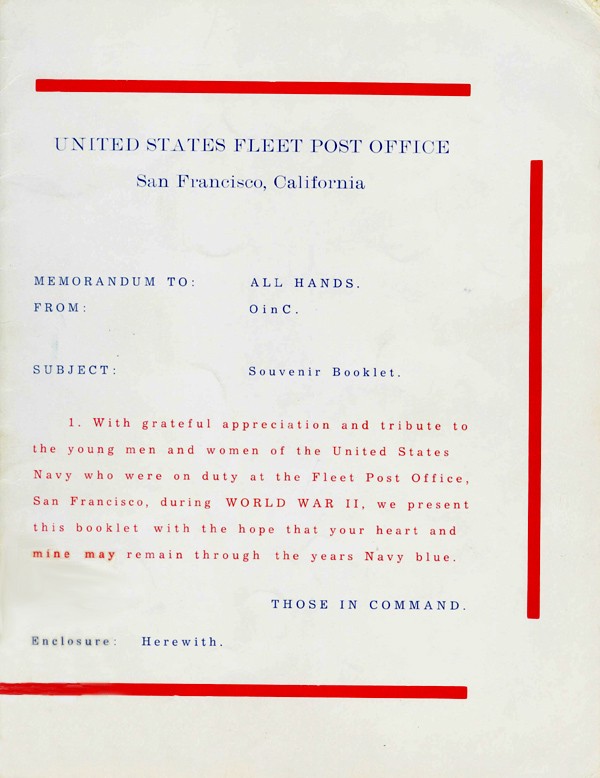
United States Fleet Post Office
San Francisco, California
Memorandum To: All Hands.
From: O in C.
Subject: Souvenir Booklet.
1. With grateful appreciation and tribute to
the young men and women of the United States
Navy who were on duty at the Fleet Post Office,
San Francisco, during World War II, we present
this booklet with the hope that your heart and
mine may remain through the years navy blue.
Those in Command.
Enclosure: Herewith.
DEDICATED
TO
ADOLPH MAURER, CY, U. S. N.
Adolph Maurer, Chief Yeoman, USN, welfare officer without portfolio, handled duties as confidential aid to the Executive Officers of the Fleet Post Office.
He joined the Navy in 1917 in Peoria, Illinois and served in the Atlantic in World War I. At the close of the war, he was assigned to the United States Naval Transport Service and remained on that duty for sixteen years. While on this assignment he visited numerous islands in the Southwest Pacific as well as in the Philippines, China and Japan. He has crossed the Pacific to the Orient some fifty-odd times.
Mauer served in the Atlantic Convoy Service during World War II, plying from Newfoundland to Iceland and the British Isles; also in the Southwest Pacific, basing in the Fiji Islands.
"The Chief," as he was affectionately known to all, reported for duty at the Fleet Post Office in April, 1943. He is small in stature, very quiet, and has a knack for getting things done to the best advantage of all concerned. What the Chief won't tell us, about himself, his associates will! He was a friend to all; . . . whether it meant getting a seat on a NATS plane or Baked Beans for a picnic.
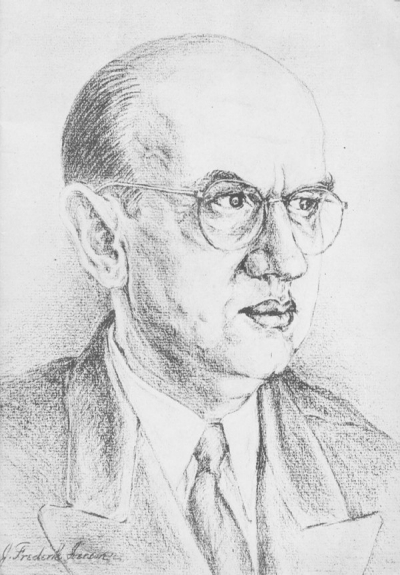
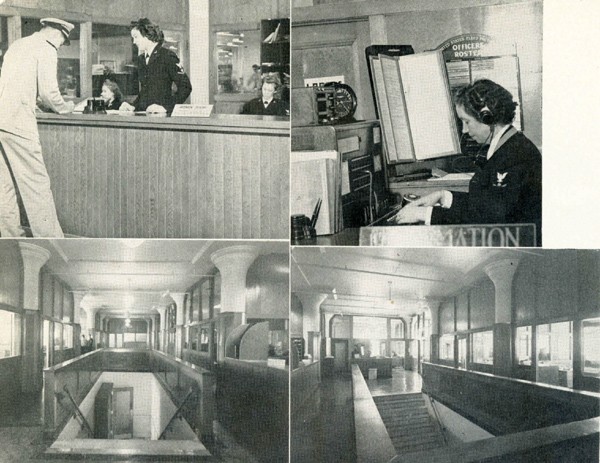
YOU'RE ABOARD!
Shown above are personnel offices and entrance to Fleet Post Office, 651 Brannan Street, San Francisco. Many were they that passed through these doors!
OFFICERS ALL:
Commanding Officers As They Served:
Captain Edwin H. Dodd, U. S. N. (Ret.) February 12, 1943 to January 15, 1944.
Captain J. C. Clark, U.S.N. (Ret.) January 1944 to November 1944.
Commander Ferd R. Hayes, U.S.N.R., November, 1944 to March 1946.
Commander W. J. Hegarty, U.S.N.R., March, 1946 to June 1946.
Lt. Cmdr. Claud F. O'Hara, U.S.N., June 1946.
Lieut. G. A. Campbell.
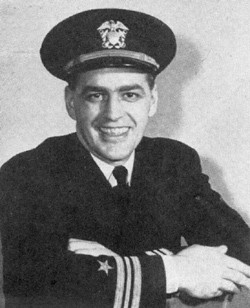
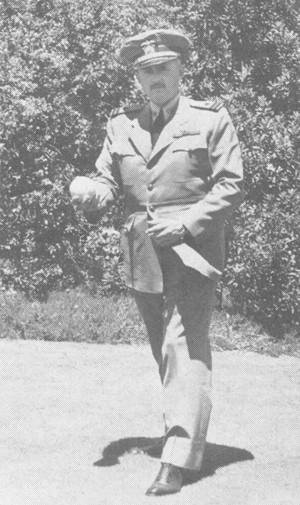
OFFICIALLY SPEAKING
Upper Left: Commendation to Commander Ferd R. Hayes, U.S.N.R.
Upper Right: Officers on duty during 1945.
Lower Left: Major Eugene Bradford, U.S. Marine Mail Chief.
Lower Right: Captain Edward H. Dodd (left) turns C. O.'s office over to Captain J. C. Clark in January 1944.
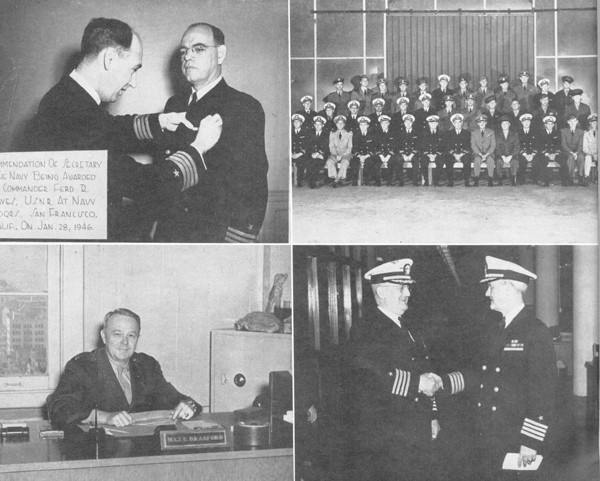
A N N A L S O F T H E
F L E E T P O S T O F F I C E
World War II has come and gone. The break of a peaceful day has set upon us once again and the fury and weariness of a people at war has passed into but memory. Somewhere in the future men and women will dwell for a few seconds on incidents which happened during World War II. Where were you and what did you do during this war? You'll have many things to tell, won't you? Some of your stories will be about Fleet Post Office, San Francisco. To help you over the rough-spots of those sea stories you will dream of in future days, here is the story of that great Naval shore establishment . . . . whose motto was not "the mail must go through" but "the mail did go through"!
Before the war, in the good old peacetime years just before Pearl Harbor, the U. S. Navy received mail direct from civilian post offices. Locations of stations remained permanent and presented no problem as to mail delivery as it was directed to the city and state where each particular naval station was located. In the case of ships and aviation units which were afloat, other arrangements were required. The procedure proved most successful and was simple in operation. This consisted of direct negotiations between the commanding officers of a ship and the postmaster. Ship's mail was sent to the city where it spent most of its time in port . . . in care of the postmaster of that city. The postmaster in turn would have the mail delivered to a designated office on the dock where the ship's mail clerk picked up the mail. Before a cruise the postmaster was advised of the schedule and the mail was forwarded accordingly. To expedite mail delivery, personnel usually advised their correspondents of the ship's movements and mail was addressed direct to port cities in care of the postmaster.
After Pearl Harbor, when wartime secrecy shrouded the movement of ships, it became necessary to have a central distribution point. Two main Navy post offices were established - one in San Francisco, California and one in New York City. All mail for ships and stations in the West or Pacific Ocean was directed to San Francisco. Mail for East Coast Stations and the Atlantic Ocean went to New York City. In this manner the locations of ships and stations remained unknown to all with the exception of those charged with routing the mail.
Fleet Post Office, San Francisco was placed into commission on May 1, 1942 with Captain Edwin H. Dodd, now U. S. N. retired, in command. However, it was not until February 12, 1943 that Captain Dodd received written orders which placed him as Officer-in-Charge, Fleet Post Office, San Francisco, including V-Mail Division, Fleet Records Office and for the supervision of handling mail for the Merchant Marine and Armed Guard. At the beginning, Fleet Post Office, San Francisco had a complement of four officers and one hundred seventy-five men. Headquarters were set up at 651 Brannan Street in the building which housed the John Deere Plow Company.
With the commission of Fleet Post Office, addresses which formerly were given to geographical locations of ships were changed overnight to: "In care of Fleet Post Office." This involved the increase of addresses from a comparatively small peacetime Navy of a few foreign stations to a list of over 33,000 addresses of active ships and stations. And with these changes, the Fleet Post Office grew. In 1944, Fleet Post Office had buildings at 651 Brannan Street, 1000
Van Ness Avenue, 623 Mission Street and at its pier of mail embarkation. Personnel reached an all time height of 6,000 enlisted men and women and approximately 50 officers.
Mail began to flow out of the post office at such tremendous outgoing bulk that the count was beginning to be almost impossible. In 1944, between October 15 and December 15, almost 17 million packages passed through the F.P.O. All packages had cleared the shores of the United States by December 1st. The early parcels reached their destination so early that thousands of people sent the second package in order that a parcel would be received nearer to Christmas.
The actual count for the year 1945 is given in figures below so that you may know the extent of the volume of mail that was handled. This report was taken from the files of Lt. Commander S. B. Rafalovich, U.S.N.R. Comdr. Rafalovich served as Operations Officer and was given much credit for his command of the movements of the mail.
1945 |
FPO |
Total AG&MM |
V-Mail |
Grand Total |
January February March April May June July August September October November December
|
71,854,396 73,801,403 94,952,644 93,770,930 96,793,706 93,534,994 99,038,975 96,721,309 90,010,600 96,489,221 72,747,896 66,282,868 1,045,998,942
|
2,879,377 2,396,981 2,920,055 2,373,521 2,400,613 2,416,657 3,004,779 3,037,795 2,435,966 2,241,831 1,799,740 1,560,498 29,167,813
|
1,263,175 1,154,198 1,367,078 982,816 935,470 737,061 555,467 410,030 215,857 76,397
_________ 7,697,549
|
75,996,948 77,352,582 99,239,777 97,127,267 100,129,789 96,688,712 102,599,221 100,169,134 92,662,423 98,307,449 74,547,636 67,843,366 1,083,164,304
|
Not to be forgotten were the 65 civilians who worked at the F.P.O. Fleet Record Office. Of this 65, three saw the beginning and the end of the Fleet Record Office. They were: Mrs. Grace Gray, Mrs. Josephine Moulthrop and Miss Margaret Henley.
The war ended. Fleet Post Office, San Francisco began to fold . . . . but the work done there can never die for through their work they kept hope alive . . . . and through hope was won the war!
GOBS ON THE JOB
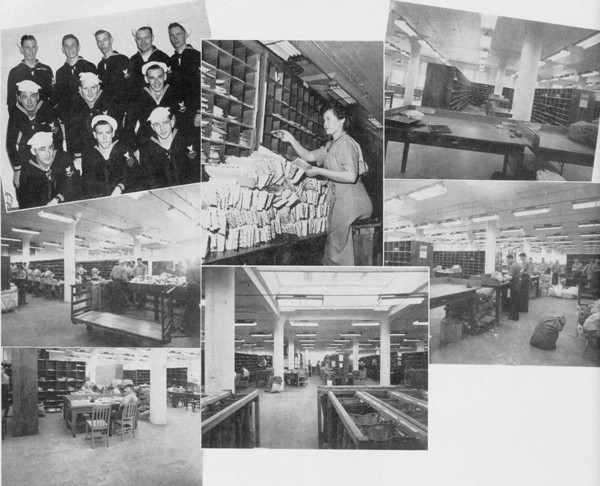
AIR MAIL
Air mail is by far the most popular of all mailing systems and it is no wonder that it was the largest department in the Fleet Post Office. Beginning back in the early days of the war, in May, 1942, the airmail division started out with a small number of crewmen distributing only 23 mail pouches per day. Only a year later the figure had grown to 130 pouches per day. By another year, it had risen to an average of 495 pouches per day. It has been estimated that approximately 1,300,000 letters were dispatched each day.
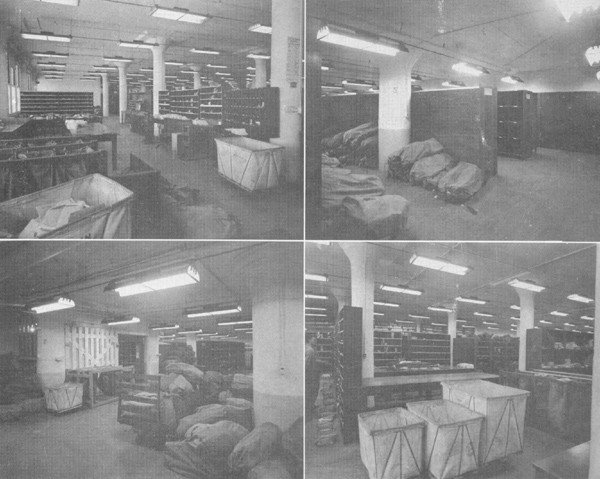
FIRST CLASS
Known to civilians as ordinary (3 cent) mail. In one year over 254,870,734 letters passed through this section.
ARMED GUARD AND MERCHANT MARINES
With approximately 350 personnel these men at AG&MM kept mail rolling to armed guard crews as well as merchant marines in the Pacific throughout the war!
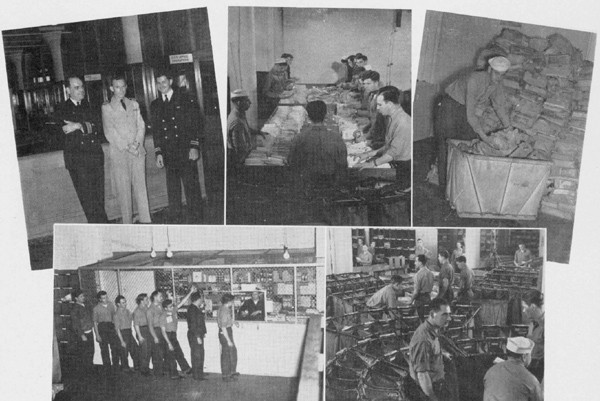
PARCEL POST AND PRINTS
The second largest section of the Fleet Post Office is the Parcel Post and Prints Section. Its complement of 520 daily handled thousands of sacks of parcel post and newspapers.
The section used the first and third decks of the Fleet Post Office Building at 651 Brannon Street. The Parcel Post and Dispatch Sections moved into a new building in Oakland in September, 1946.
The new building called for 200,000 square feet of working space, plus 35,200 square feet for loading docks. There was a separate building of 25,000 for offices, lockers, and a cafeteria. The location of the new building was near Camp Knight in Oakland. This was just north of the Bay Bridge leading out of Oakland, California.
This new building was urgently needed for a long time, since the daily average of sacks worked had increased from 3,642 in March, 1944, to 8,859 in March, 1945. The daily average for October, the peak month during the 1944 Christmas rush, was 22,228 sacks. In 1945 an estimated 30 million parcels passed through the Fleet Post Office during the Christmas rush.
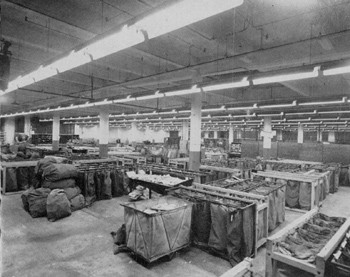
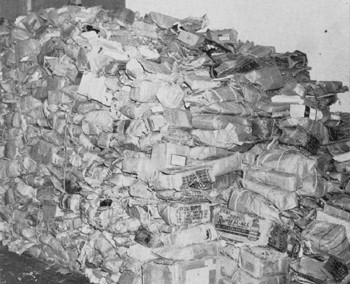
LOCATOR SECTION
Here the addresses of 33,000 ships and stations were kept secret and on hand so that mail could be rushed to men in the Pacific.
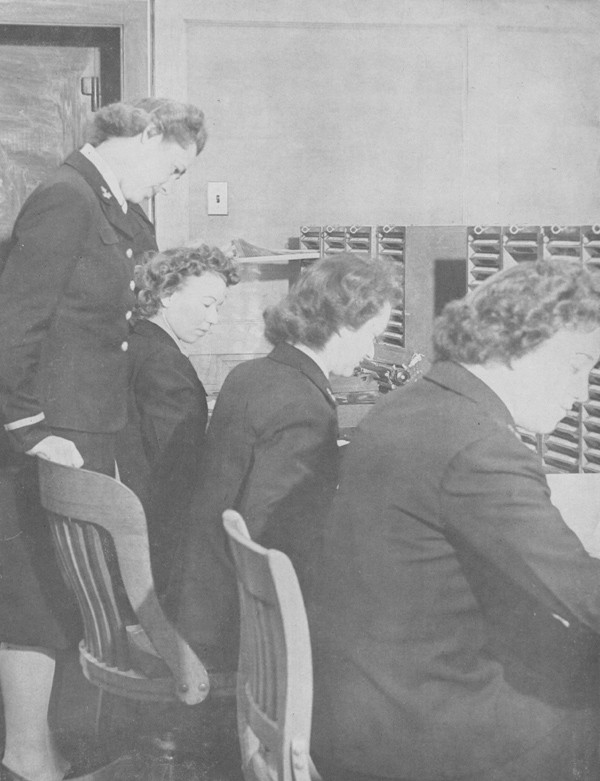
THE UNITED STATES NAVY'S FLEET RECORD OFFICE
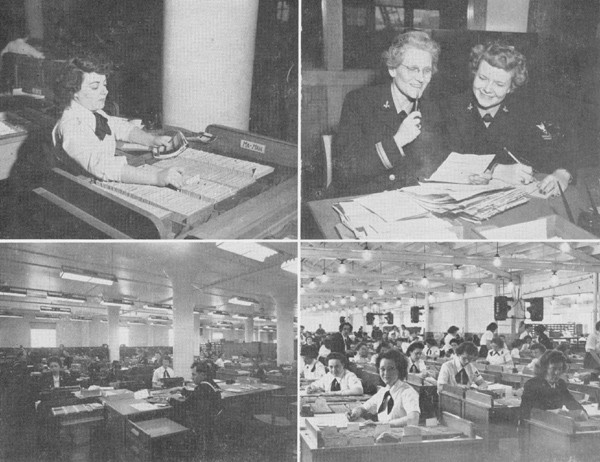
CARDS OF VICTORY
By JO MOULTHROP
Of the United States Navy's Fleet Records Division, Pacific
This is the story of the United States Navy's Fleet Records Division, born December 7, 1941, at Pearl Harbor.
Row upon row of small white cards . . . millions of them, standing primly in hundreds of file trays . . . bore witness to the deeds of the men and women who comprised the personnel of the world's greatest Navy.
The cards were more than mere records of the Navy's men and women, of their stations, their changes in ratings or rank. They were truly "cards of victory," each one bearing testimony of the American will to avenge Pearl Harbor and wipe out the aggressors.
Some cards are no longer white. These tell the story of men moved from station to station, ship to ship, across the Pacific and up from the South Seas to the north. Here is one that will bear no further legend; its last marking reads, "Died in Action."
Each day of each month, as the war moved on in history, new cards were added to the trays and old cards brought up to date. Just as a historian records each major event for the enlightenment of the world's generations to come, so did the Navy's "victory cards" record, although in minuter detail, the steady progress of the march on Tokyo.
Purpose of the cards was two-fold. First, to provide a means of forwarding mail to men far from home. Second, to help administrative officials trace individuals with a minimum of lost time.
The complexity of modern Naval warfare becomes more apparent when the Fleet Records cards are studied. The process of moving men to the ocean fighting fronts and to supply bases loomed tremendous when seen through the personnel cards. Despite this complexity, however, it became even more apparent that the Navy was not a top-heavy, bureaucratic figure of speech, but an acutely living, breathing force of individuals. . . of men named Jones, Smith, Kowalewski, Lischka, Fernandez.
From Aab to Zyzneski, from first to last, from five-star Admiral to apprentice seamen the cards were filled with personal achievements, and each one bears within its marking pathos, glamour, perhaps true heroism, and sometimes tragedy.
The man who "founded" the system is Chief Yeoman Frank E. Holec, now retired. He was aboard the proud old battleship WEST VIRGINIA when it was sunk at Pearl Harbor, and fought his way to shore through burning oil and flying shrapnel to play a part in Naval history.
Once ashore, Holec assembled a crew of volunteers and, from the oil smeared, water stained, shell torn scraps of paper available, instituted the Fleet Casualty Records Office, now the Records Division of the Fleet Post Office.
Since that time, the handful of records has grown to a collection of more than 2,000,000 cards, kept up to date by a system of reports from every ship and station of the Navy.
The war proved long, but the way to victory was certain. The men and women of the Fleet Records Division proved it by their cards.
V-MAIL
To conserve space a new type of mail came about during World War II
. . . . . that of Photographing your writing and sending by file to distant ships and stations.
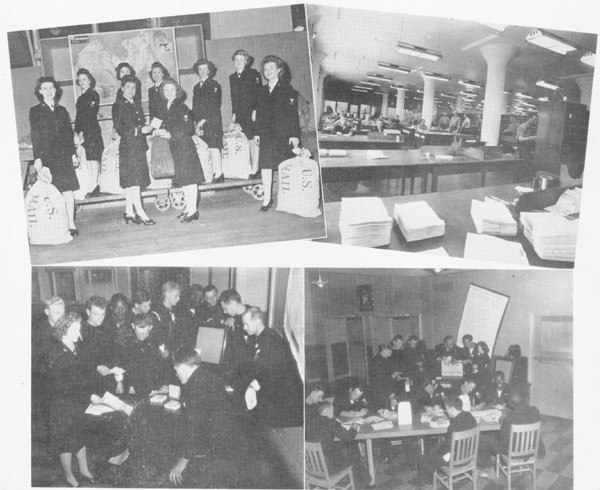
MARINE MAIL
At 1000 Van Ness Avenue, San Francisco, 500 Marine men and women carried on the work of getting mail to the Marines overseas under the supervision of the U.S. Navy. They were a part of the Fleet Post Office.
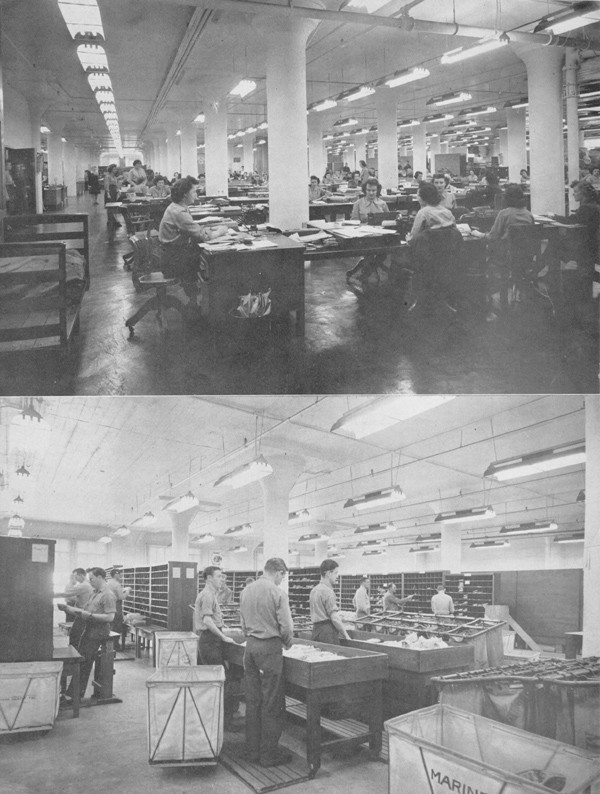
THE ORCHESTRA
| ORGANIZED: | FEBRUARY 1945 |
| DISBANDED: | JANUARY 1946 |
| ENGAGEMENTS TOTALED WERE: | |
| 22 22 16 12 8 5 6 20 |
F.P.O. chow music engagements. Other unscheduled chow engagements. Stage door canteen appearances. F.P.O. dances. Officer's F.P.O. Dances. St. Mary's U.S.O. Appearances. Apostleship of the sea U.S.O. Other engagements. |
F.P.O. ORCHESTRA BECAME "SPOTLIGHT BAND" OF THE 12thND
On the 14th of December 1944 the first F.P.O. notice was issued to all personnel requesting all individuals who had any experience with musical instruments to report such information to the Executive Officer. This was the start of the F.P.O. band. Gordon Patton, MaM 2c, was aboard at the time and was appointed as director of the organization. Within a short while approximately fifteen people joined the band and were given auditions. Their first appearance was at the officers party at the Tivoli Café on January 21. Five members of the band made up a unit for this affair.
The first public appearance occurred on 14 February when they played for the USO at Harrison and Fremont streets, San Francisco. The first F.P.O. dance in which the whole orchestra played was on 2 March at the Veterans' Auditorium. Thereafter, the reputation of the F.P.O. orchestra had grown constantly and they entertained at various USO's, at the Stage Door Canteen, and the Yosemite Naval Hospital at Yosemite National Park.
The next important engagement for the orchestra was June 8 when they made their first recording at the Office of War Information. These recordings were used for short wave broadcasting to all the Allied Nations and to our armed forces overseas.
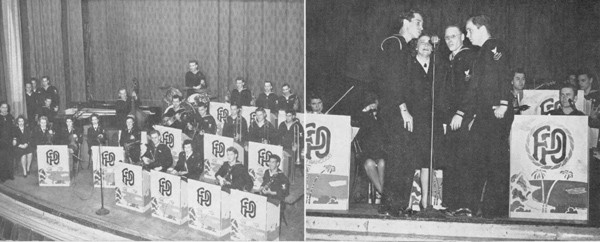
THE NEWSPAPER:
In the following reprinted editorial, you will find the history of the F.P.O. Newspaper . . . . . "Letter Pusher"
| LETTER PUSHER | |
| Published at the Fleet Post Office, San Francisco, California, by the Welfare and Recreation Department, without cost to the United States Government, under BuPers Manual directive, arts, E7601 to E7604. The Letter Pusher receives Ship's Editorial Association Material. | |
| OFFICER IN CHARGE | Commander W. J. Hegarty, USNR |
| EXECUTIVE OFFICER | Lieutenant-Commander C. R. O'Hara, USN |
| WELFARE AND RECREATION OFFICER | Lieutenant Leon Szura, USNR |
| EDITOR | Martha Piper Thomas, Y3c |
| ARTIST | Dick DiMattos, S1c |
EDITORIAL
It has been said that the author who speaks about his own books is almost as bad as a mother who talks about her own children. But please, mates, may I speak a final word in this last edition of "Letter Pusher"?
You see, we've been publishing this sheet for one year now and the time is here (with this issue, in fact) when we put the typewriter in the desk, roll the copy into a file and shove off! As it happens, I've fed copy to the machine in front of me for 14 months now and it in turn, through a long process, somehow reached you. But with a farewell word there will be no copy reaching you again so stand by for a word of thanks from a grateful editor.
As a crew you have been the finest mates in the world! You read this junk every time we print and are kind enough to keep your opinions behind my back. We have pictured you to death - even shot at you with flash bulbs! We've dug your life histories from every spot of the United States. We manage to find the corniest jokes ever told - and mostly retold - but bless you all, you've stood by and read such as it was because it was your paper.
Hints and help from left to right enabled me to shove this to you and where did they come from? Well, they popped in from the crew who were always willing to cooperate. My deepest appreciation and thanks to: first, the contributors to various editions; next, to those who backed the paper - its readers; and last, to the boys who begged for copies overseas.
Mates, this paper began behind a dinky typing desk in the Fleet Records Typing Section in February of 1945. The first news sheet was a typewritten, carboned copy sheet containing Fleet Records news. From that grew the idea of a newspaper for the entire Post Office, although it was not the first time an idea such as this had arisen. Plans, requests and a sample issue were submitted and in March the o.k. to print came from Washington. With limitations too numerous to name, the staff put out the first issue - a multilithed edition - bearing the name "Letter Pusher" after a group of judges chose the name in a contest for such.
The staff dwindled . . . and dwindled . . . and dwindled! Then there was one! Now I stop for a moment to join you in thanking the members of the early "slave day newspaper." For their help and loyalty to the paper, laurels to: James Bodey and Dick DeMattos, artists; Frank Drachman; business manager; Corporals Cal Watson and Emily Sewall from the Marines; Hazel Jordan for her contributions to each edition; Vic Ritchey for the first multilithed copies; and to civilian Jo Moulthrop, Fleet Records Typing head, for her encouragement and help in the early days. Appreciation also goes to the three advisory officers - Lieuts. E. A. Schmidt, Sidney Ritt and Leon Szura. My special thanks goes to Lieut.-Comdr. C. F. O'Hara.
"Here's to the press: the tongue of the country . . . may it never be cut . . . the newspaper: may it fight like an army in the defense of right . . . with strong columns and good leaders . . . the pen: may it ever be a sword to pierce wrong doings and falsehood to the heart . . . the press: where it is free, the people are free . . . where it is fettered, they are slaves."
All stations have newspapers but all editors do not have a crew such as ours to write for. The copy is choking in the machine and I doubt that a goodbye will print. Good luck to all of you wherever you go - MAKE NEWS - the "Letter Pusher" press has gone to bed!
THROUGH THE PORT HOLE
Here you have pictures of activities aboard the good ship. A page of remembrances!
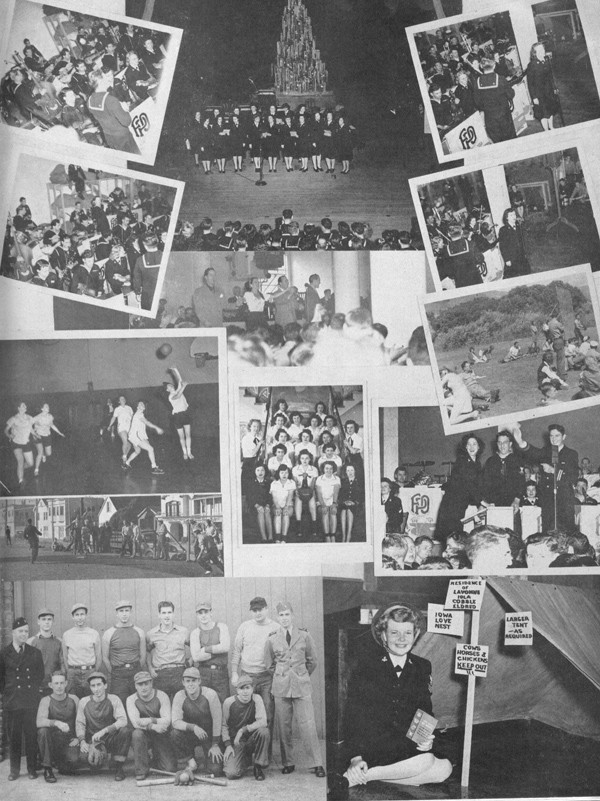
CHRISTMAS MAIL!
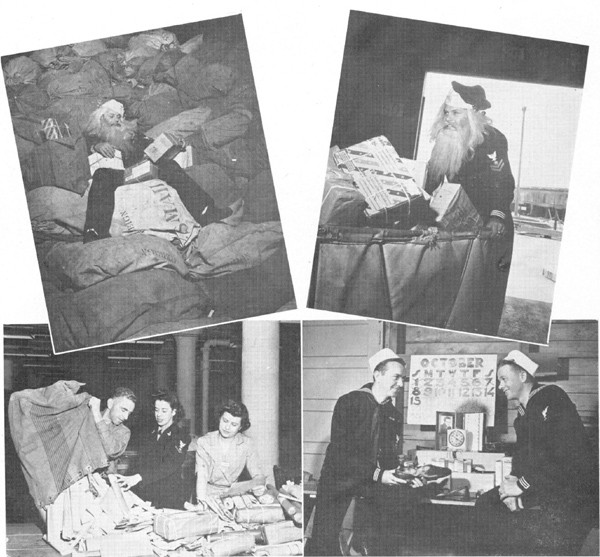
LIBERTY CITY
This strange, beautiful city of the Golden West . . . . this city known as San Francisco . . . . sitting on hills that overlook a harbor . . . this city that belongs to the memory of every F.P.O. crew. Here is the remembered Powell Street cable cars, the Mission Delores, Fisherman's wharf, the Golden Gate and the Oakland Bay Bridges, Coit Tower, the Beach, Chinatown and the Ferry Building!
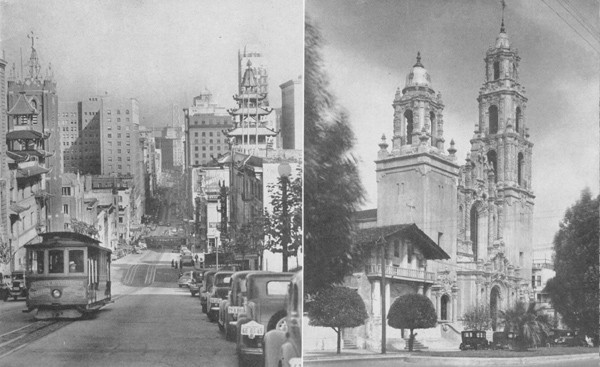
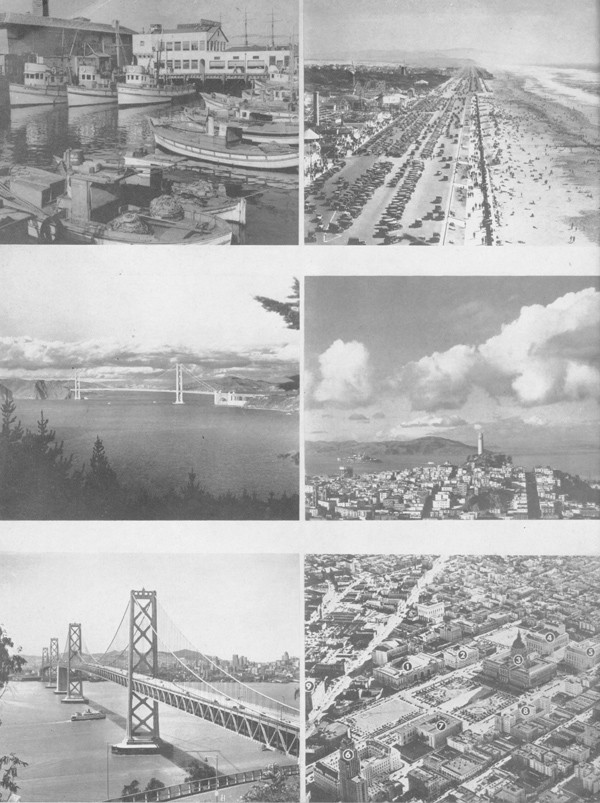
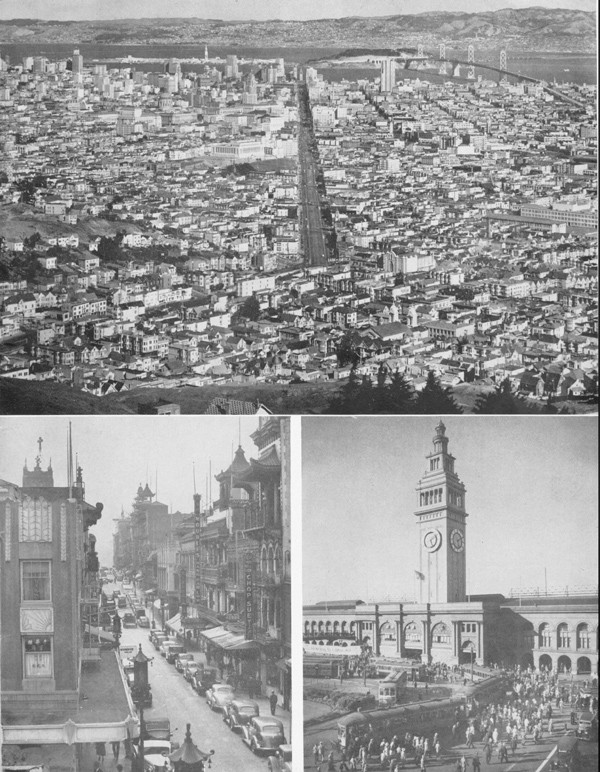
THUS IT WAS ENDED!
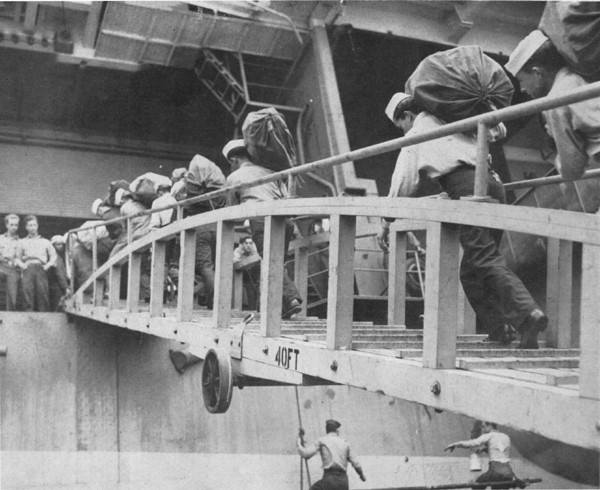
With the sound of Taps, the F.P.O. San Francisco
closes a chapter in the history of World War II.
[END]
Footnotes

- Accessibility/Section 508 |
- Employee Login |
- FOIA |
- NHHC IG |
- Privacy |
- Webmaster |
- Navy.mil |
- Navy Recruiting |
- Careers |
- USA.gov |
- USA Jobs
- No Fear Act |
- Site Map |
- This is an official U.S. Navy web site


